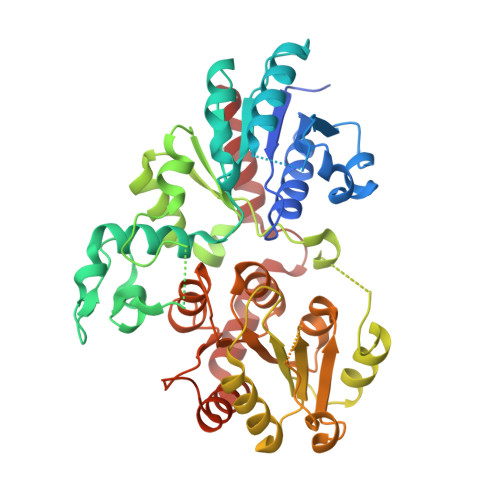Structural and biochemical basis for regiospecificity of the flavonoid glycosyltransferase UGT95A1.
Sirirungruang, S., Blay, V., Scott, Y.F., Pereira, J.H., Hammel, M., Barnum, C.R., Adams, P.D., Shih, P.M.(2024) J Biological Chem 300: 107602-107602
- PubMed: 39059496
- DOI: https://doi.org/10.1016/j.jbc.2024.107602
- Primary Citation of Related Structures:
9BCM - PubMed Abstract:
Glycosylation is a predominant strategy plants employ to fine-tune the properties of small molecule metabolites to affect their bioactivity, transport, and storage. It is also important in biotechnology and medicine as many glycosides are utilized in human health. Small molecule glycosylation is largely carried out by family 1 glycosyltransferases. Here, we report a structural and biochemical investigation of UGT95A1, a family 1 GT enzyme from Pilosella officinarum that exhibits a strong, unusual regiospecificity for the 3'-O position of flavonoid acceptor substrate luteolin. We obtained an apo crystal structure to help drive the analyses of a series of binding site mutants, revealing that while most residues are tolerant to mutations, key residues M145 and D464 are important for overall glycosylation activity. Interestingly, E347 is crucial for maintaining the strong preference for 3'-O glycosylation, while R462 can be mutated to increase regioselectivity. The structural determinants of regioselectivity were further confirmed in homologous enzymes. Our study also suggests that the enzyme contains large, highly dynamic, disordered regions. We showed that while most disordered regions of the protein have little to no implication in catalysis, the disordered regions conserved among investigated homologues are important to both the overall efficiency and regiospecificity of the enzyme. This report represents a comprehensive in-depth analysis of a family 1 GT enzyme with a unique substrate regiospecificity and may provide a basis for enzyme functional prediction and engineering.
- Department of Plant and Microbial Biology, University of California, Berkeley, CA, USA; Feedstocks Division, Joint BioEnergy Institute, Emeryville, CA, USA; Environmental Genomics and Systems Biology Division, Lawrence Berkeley National Laboratory, Berkeley, CA, USA; Center for Biomolecular Structure, Function and Application, Suranaree University of Technology, Nakhon Ratchasima, Thailand.
Organizational Affiliation:
















